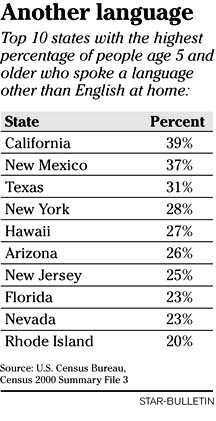
Isle bilingualism
on the upswing
since ’90 censusOne in four residents
over age 5 speaks a language
other than English at home
About one in four Hawaii residents over age 5 speaks a language other than English at home, the fifth-highest percentage in the nation, a U.S. Census study shows.
Nationwide, about 47 million Americans, or 17.9 percent of those over 5, live in a household where English is not exclusively spoken.
In Hawaii, an estimated 302,125 people, or 26.6 percent of those 5 years and older, used a language other than English. The vast majority -- 267,157 -- speak an Asian or Pacific Island language.
Slightly more than half, about 158,620, also speak English very well, according to estimates based on the 2000 Census. The rest, about 12.7 percent of those over 5 in the state, have difficulty with English.
About 161,721 residents live in a household where everyone speaks a non-English language, and 63,304 people in Hawaii are considered "linguistically isolated," meaning no one age 14 or over in the household where they live speaks English at least "very well."
The numbers are 18.9 percent higher than in the 1990 census, when the bureau estimated 254,724 or 24.8 percent of the population over 5, spoke a non-English language at home.
The estimates are not surprising considering the amount of immigration to Hawaii, said Melba Bantay, program director for Catholic Charities community and immigrant services.
Changes between the 1990 and 2000 census means the state Elections Office will have to start printing ballots and election materials in Chinese on Oahu and will no longer have to print ballots in Ilocano on Kauai, said chief elections officer Dwayne Yoshina.
The language question in the census is used by the U.S. Department of Justice to administer language requirements under the federal Voting Rights Act.
The census estimates that about 39,558 school-age children live in a home where a non-English language is also spoken. Of those children, 13,585 speak English less than very well.
The census numbers are higher than state Department of Education estimates. Judy McCoy, the administrator in charge of languages, said about 12,000 public school students need help with English as a second language based on evaluations done when the children enter school.
Nationally, the Spanish-speaking population rose by 62 percent since 1990 to 28.1 million. Chinese is the language spoken most besides Spanish, with 2 million people speaking it at home. It was followed by French (1.6 million), German (1.4 million) and Tagalog (1.2 million).
California, New Mexico and Texas had the highest percentages of residents who did not speak English at home.
